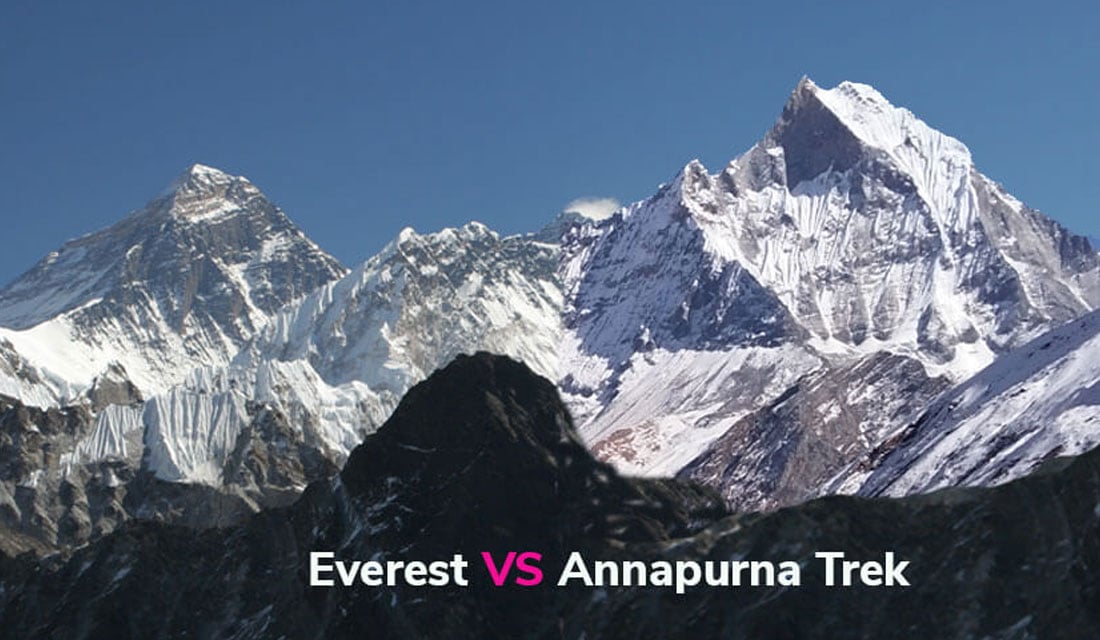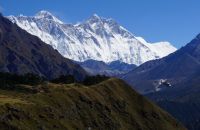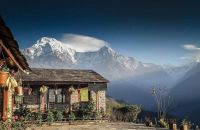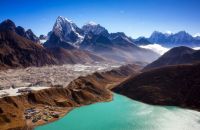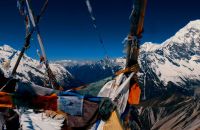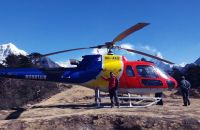Talk with our local travel specialist who can help organize your trip.
Trekking To Everest Vs Annapurna - Which One is the Best?
With the mention of trekking in Nepal, the two names that pop up in one’s mind are Everest and Annapurna.
Where should I trek Everest or Annapurna? It’s the most difficult question to answer as both are two of the best treks in the world. However, in this blog, we will tell you about different aspects of trekking to Everest and Annapurna. We will be shedding light on highlights, scenery, duration of treks, trekking routes, culture and communities, difficulty level and others. Knowledge of different aspect of each trekking region will help you decide upon the best one for you.
Without further ado let’s get into the key things to consider before deciding on a trek to Everest and Annapurna!
You will get to live the dream of watching Everest towering high in front of your eyes. Everest region has the best mountain scenery and you will be trekking beneath mountains that are over eight thousand meters. The other highlight of the trek to Everest is the Sherpa culture. Tengboche Monastery is famous among trekkers which will give you a glimpse of Buddhism practiced in high mountains.
While trekking in the Annapurna Region you will get to enjoy the variation in landscape and culture. You will get to enjoy the view of verdant hills, and high mountains and not to forget the desert-like landscape. Hindus residing in the lower elevation and Buddhist in higher altitude will give a trekker chance to see cultural variation.
The scenery of the Everest region wins hands down over Annapurna. However, cultural diversity will amaze you while trekking in the Annapurna region than in the Everest region.
Table of Content
Getting There
The popular means to reach the trek's starting point to Everest is via a flight to Lukla. If you want to avoid flight then you can start your trek from Jiri like Sir Edmund Hillary and Tenzing Norgay back in olden days. But you need to add around a week more to your trek along with the fees of guide and porter. If you aren’t keen on taking the classic route then flying to Everest is a better choice.
Pokhara is the starting point for most of the treks in the Annapurna region. You can either fly to Pokhara or take a scenic drive to the city from Kathmandu. Kimchi or Hile or Nayapul are some of the starting points for Annapurna treks which lie a few hours’ drives from Pokhara. Annapurna Circuit Trek starts from Besisahar which is 9 to 10-hour drive from Kathmandu.
Scenery
Everest's captivating mountain scenery has been described repeatedly by its spectators and its worth all praises. Trekkers who go to see Mount Everest are allured by the stunning views of peaks like Ama Dablam, Pumori and Lhotse.
A flight to Lukla from Kathmandu is scenic in itself. You will see enormous and beautiful snowcapped mountains from the airplane window as you approach Lukla airport. The first Sherpa village of the trail will be the one in Lukla. High suspension bridges, swaying prayer flags with breeze and prayer wheels to spin form an indispensable part of your Everest trek.
If you want to see the landscape variation, trekking in the Annapurna region will be best. It features terraced farmland with crops, verdant hills, quaint villages, and high mountains. Trekking in the Annapurna region will reward you with the gorgeous view of Annapurna Massif, Dhaulagiri, Lamjung Himal, and other neighboring mountains.
The trek to Annapurna Circuit will also take you to the deepest gorge in the world, Kali Gandaki. It features a trek to high altitude mountain lakes- Ice Lake and Tilicho. Ice Lake is situated at an altitude of 4600 meters and Tilicho at an elevation of 4920 meters.
If you think the scenery only features mountains then let me burst that pre-conceived notion. Annapurna Circuit with tilicho lake Trek will take you to Lower Mustang with an arid landscape resembling a desert. Mustang lies close to Tibet and many people also say that its landscape resembles the Tibetan plateau. The dominance of Tibetan Buddhist culture practiced in the region also adds to the Tibetan vibe.
Culture And Communities
When trekking in the Everest region, you will come across Sherpa culture. Sherpas are of Tibetan culture and follow Tibetan Buddhism. You will stay in a tea house which is basically a house where a Sherpa family lives and accommodate trekkers. During your stay, you will get a glimpse of the daily lives of local people. If you start trekking to the Everest region from Jiri, you will witness Rai and Tamang culture and Sherpa culture.
Moreover, Mani stones, prayer wheels and prayer flags are an important aspect of Tibetan Buddhism. Mani stone is a small or big stone engraved or painted with a Buddhist mantra. The act of building Mani stone is a form of prayer and is a way of showing devotion towards their deity. These stones are found alongside trail, rivers and also near the entrance of villages, monasteries. On your way to the bustling city of Namche Bazaar in Everest, you will get to see big and colorful Mani stones.
The mantra printed prayer flags are in five different colors and each hue signifies an element. White is for air, blue represents the sky, red symbolizes fire, green represents water and yellow stands for the earth. Together they represent balance. Mantras are printed on flags and when they sway with the breeze it is believed to spread positive energy and goodwill.
A prayer wheel is a cylindrical hollow wheel mounted on a spindle for spinning. The spindle contains thousands of mantras written on a scroll. It is said that turning a prayer wheel is equivalent to chanting thousands of mantras. Also, by spinning a prayer wheel you accumulate merit which helps all beings in the world and purifies their karma.
Featured Trips
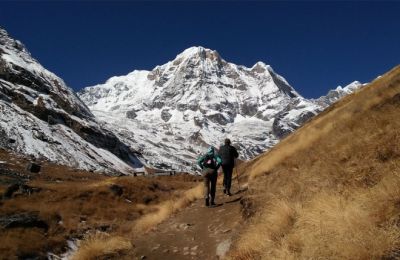
Annapurna Base Camp Trek - 11 days
Annapurna Base Camp Trek - 11 days takes you close to the world's 10th highest mountain, Annapurna I, Gurung culture, rhododendron forest, and terraced fields.
Inquire Now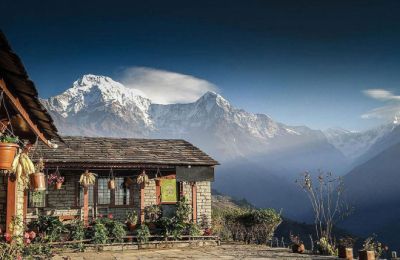
Ghorepani Poon Hill Trek - 7 days
Ghorepani Poon Hill Trek –7 days offers the best views of Himalayan range from Poon Hill. Trek under the foothills of the Annapurna range. An ideal family trek.
Inquire Now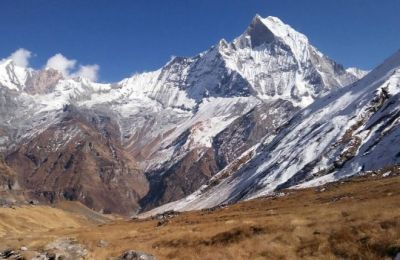
Annapurna Base Camp Short Trek - 7 days
A wonderful opportunity to visit ABC in a short span of 7 days. Annapurna Base Camp Short Trek is a safe trip with an experienced local guide. You can explore Gurung villages and walk close to Annapurna I, the 10th highest mountain in the world.
Inquire NowWhere to travel next?
Get help from our travel specialists for holiday ideas that matches your interests.
While trekking in the Annapurna region you will mostly encounter locals from Gurung, Magar, and Thakali ethnic group. Upon trekking to the higher elevation you will come across Mani walls, prayer wheels and monasteries representing Tibetan Buddhist culture. Don’t miss the opportunity of knowing more about the mountain culture by interacting with the locals.
Visit the temple of Muktinath on your Annapurna Circuit Trek which is sacred to Hindu and Buddhists. Muktinath is famous as Mukti Kshetra in Hinduism which means a place of liberation. The main temple dedicated to Lord Vishnu is one of the ancient Hindu temples. According to legends, Guru Padmasambhava meditated in Muktinath for some time on the way to Tibet. For Tibetan Buddhists, Muktinath is among 24 Tantric places and is the place where Dakinis- the sky dancers well.
Upper Mustang is one of the main attractions of the Annapurna region. Due to the isolation for centuries, the culture and traditional practice of Upper Mustang is unscathed. It has a unique culture and tradition close to that of Tibetan Buddhists.
Duration Of Trek
How long do you wish to spend in the Himalayas of Nepal? The duration is a very important aspect as it limits or broadens your options available for trekking in Nepal.
If you plan to trek in the Everest region, you need to separate at least 8 days. If time permits, you can extend trekking in Everest up to 18 days. The standard trek to Everest Base Camp is done in 14 days. It is possible to shorten the standard trek of Everest Base Camp to 12 days by trekking to Everest Base Camp and returning via helicopter.
Tread on the path less taken by extending your Everest Base Camp trek with Gokyo Lakes and Cho La Pass for 18 days. Also, go on Gokyo Lakes, Gokyo Ri and Renjo La pass trek of 14 days.
Want to enjoy the beauty of the Everest region but short of time? A combination of trek and helicopter ride can be done in a mere 8 days. Trekking isn’t your cup of tea but you want to see Everest in front of your eyes? Take a day tour of Everest via helicopter and feel the cold breeze in a brief stopover at Kala Patthar. A popular vantage point to see Everest is Kala Patthar.
Trekking in the Annapurna region of Nepal is more versatile than trekking in the Everest region. The duration of the trek ranges from 9 to 16 days. Ghorepani Poon Hill trek is of 9 days while the Annapurna Base Camp trek is 11 days. If you can spare two weeks or more, do Annapurna Circuit Trek of 16 days or Annapurna Sanctuary Trek of 14 days.
When short of time you can do the Ghorepani Poon Hill trek. The trek can be shortened to 4 days when starting and the ending point of the trek is Pokhara. It is an easy trek which is ideal as a family trek with kids or for novice trekkers. You will be walking beneath Annapurna range and witnessing a stunning sunrise over the stunning Himalayan range from Poon Hill within a short period.
Trekking Routes
Trek to Everest Base Camp is the most famous trek in the Everest region. A flight from Kathmandu will take you to Lukla. Everest Base Camp Trek route follows the trail from Lukla to Namche via Phakding. Enjoy the acclimatization day in Namche along with a hike to Hotel Everest View overlooking a wonderful view of Mount Everest. Dingboche will be your second stop for acclimatization on your way to Everest Base Camp. On acclimatization day hike through villages or neighboring hills for stunning views of Makalu, Ama Dablam and others. Trek to the base camp of the highest mountain in the world, Everest via Lobuche and Gorak Shep. Return via Pheriche and Namche to Lukla.
If you want to enjoy the best of both worlds trekking and helicopter ride then take a combination of Everest base camp trek and helicopter tour. Trek to Everest Base Camp following the same itinerary as above and fly back by helicopter. With a ride in a chopper, you can shorten the trekking duration of 14 by 2 days.
Want to bask in the beauty of the Everest region with the least trekking accompanied by aerial views? Book a trek to the Everest region with a helicopter tour of Everest Base Camp and Gokyo of 8 days. Fly to Lukla and trek to Phakding and Namche Bazaar. Enjoy a day at the bustling Sherpa town Namche Bazaar. Hike to see Mount Everest from the famous vantage point of Everest View Hotel. On the next day, hop into a helicopter and enjoy the Everest region's breathtaking views, including Gokyo lakes. Feel the cold air in your brief stopover at Kala Patthar and enjoy the best view of Mount Everest from this vantage point. Fly over stunning Gokyo lakes and glaciers and fly parallel to the jagged mountain summits.
Are you up for a challenging trek in the Everest region? Trek to spectacular Gokyo Lakes and Renjo La Pass in 14 days. Fly to Lukla and trek to Namche Bazaar through Phakding. Enjoy a day in Namche Bazaar which is dedicated to acclimatization. Take a hike to Hotel Everest View a vantage point to see Everest and neighboring mountains. Also, you can choose to relax in coffee shops, bakeries or restaurants in the Sherpa town. You will be trekking to Gokyo via Phortse Thanga and Machhermo. Pat on your back as you cross Renjo La Pass via Gokyo Valley. Return to Namche Bazaar via Lumde. The trek comes to an end in Lukla.
Are you searching for a trek in the Everest region filled with challenges? Trek to Everest Base Camp and Gokyo Valley via Cho La Pass in 18 days. Cho La Pass is one of the high mountain passes over 5400 meter. Fly to Lukla and tread to Phakding followed by Namche Bazaar. After acclimatizing at the bustling town of Namche Bazaar, trek to Dingboche via Tengboche. An acclimatization day is necessary at Dingboche before you trek to Lobuche. Trek to Gorak Shep and you can either visit EBC or Kala Patthar on this day. If you didn’t go Kala Patthar for sunset day before, wake up early to witness one of the best sunrises. Tread to Dzongla and cross Cho La Pass on your way to Thaknak. Your next destination is Gokyo and Gokyo Ri followed by Machhermo and Namche. Trekking to Lukla via Phakding marks the end of your trek. You will be boarding on a flight from Lukla to Kathmandu.
Enjoy 11 days of Annapurna Base Camp Trek which takes you to verdant hills and a glacial sanctuary surrounded by Annapurna massif. Trek to Gurung village at Ghandruk and experience their hospitality. Walk past Chhomrong, Bamboo, and Deurali on your way to Annapurna Base Camp. You will reach an amphitheater of mountains 7,000 to 8,000 meters high. Also, spot the 10th highest peak in the world, Annapurna I.Soakinnatural hot spring at Jhinu Danda. Trek for few hours to Siwai which marks the end of the trek and drive to Pokhara. During the Annapurna Base Camp trek you will cover a total distance of 115 kilometers.
Take a short drive to Nayapul from Pokhara, the starting point of your Annapurna Sanctuary Trek (14 days). Climb up steep and long stone stairs to Ulleri followed by a comparatively easy trail through rhododendron forest to Ghorepani. Wake up early to watch a mesmerizing sunrise from Poon Hill and hike to Chhomrong via Tadapani. Trek through Bamboo and Deurali to reach Annapurna Base Camp and Annapurna Sanctuary. Rejuvenate yourself by soaking in a hot spring at Jhinu Danda before trekking to Nayapul, the end point of the trek. Drive to Pokhara followed by a scenic drive to Kathmandu.
Trekking to Poon Hill rewards you with awesome panoramic views of the Himalayas in a short span of time. Start 9 days trek from terraced farmlands, climb the stone staircase leading to quaint Gurung and Magar villages. Walk through the rhododendron forest and relax in a hot spring at Jhinu.
Annapurna Circuit trek is one of the classic treks of Nepal. After driving from Kathmandu to Jagat via Besisahar, Annapurna Circuit's trekking of 16 days begins from Lower Pisang. Trek to Braga and enjoy an acclimatization day at Manang. Tread to Tilicho Base Camp via Sri Kharkha and witness beautiful high mountain Lake Tilicho. Cross a high mountain pass, Thororng La Pass (5460 meters). Trek down to Muktinath and Jomsom- which is the last destination of your trek.
One-time trekking in the Himalayas of Nepal isn’t enough. Many trekkers return to Nepal for trekking because they don’t want to miss out on its unparalleled beauty. If trekking means amazing mountain scenery, then do the trek in the Everest region. If you are searching for a variation in the landscape along with cultural diversity, then trekking in the Annapurna region will be apt for you!
Featured Trips
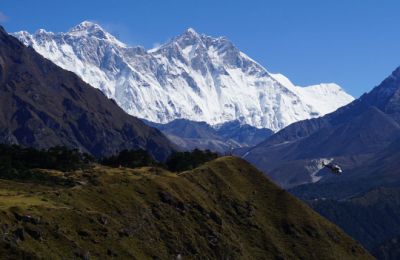
Everest Base Camp Trek - 14 days
Looking for an exciting Himalayan experience? Join us on our 14 day Everest Base Camp Trek - get ready to be stunned by breathtaking views and discover magical Nepalese cultures!
Inquire Now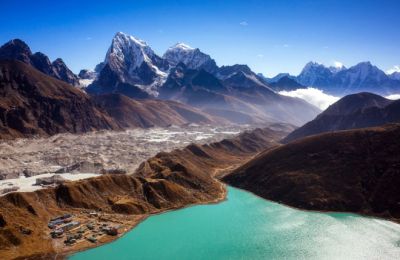
Gokyo Lakes Trek with Renjo La Pass - 14 days
Gokyo Lakes Trek 14 days take you across Renjo La Pass, the easiest pass of the Everest region. Spectacular Gokyo lakes and Everest mountain scenery.
Inquire Now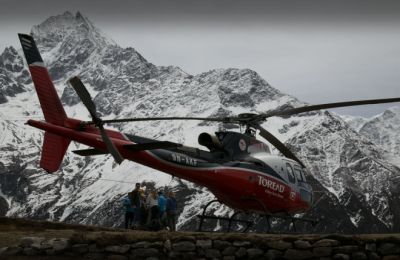
Everest Base Camp Gokyo Lakes Helicopter Trek - 8 days
Enjoy Everest Trek like never before with Everest Base Camp Gokyo Lakes with helicopter returns 8 days. Trek to EBC and spectacular flight over Gokyo Valley.
Inquire NowWhere to travel next?
Get help from our travel specialists for holiday ideas that matches your interests.
Difficulty Level
Everest region and Annapurna region both features an easy to moderate to difficult treks depending upon the route one chooses. While trekking in Everest you will be trekking in higher altitude for more number of days. As you gain altitude the air gets colder and the level of oxygen molecules decreases. You will be breathing more than you would usually in lower altitude. High altitude adds difficulty in trekking so trekking in Everest region will be comparatively difficult than trekking in Annapurna region.
If you are thinking ‘How hard is Everest Base Camp trek?’ then in terms of difficulty level, the trek is ranked easy to moderate. Trekking to Gokyo Lakes, Gokyo Ri, and Renjo La Pass of Everest region is called a moderately difficult trek. Also, trekking through Gokyo Valley and Cho La Pass is ranked as moderate to difficult trek.
Ghorepani Poon Hill Trek is the introductory trek and falls among easy treks in Nepal. The treks to Annapurna Base Camp and Annapurna Sanctuary ranks as easy to moderate treks. In terms of difficulty level, Annapurna Circuit trek is called moderate to difficult trek.
Weather Conditions And Temperature
The weather condition will be harsh as you gain altitude. During your trek in the Everest region, you will be staying in higher elevations for more number of days and nights. But your trek in the Annapurna region starts at lower region than the Everest trek. You will have warmer nights and you will be spending less number of nights in higher elevation. Anticipate temperature to dip as low as -10 degrees at nighttime above 4000 meters.
Autumn and spring are the best seasons to trek in the Everest and Annapurna region. During these seasons daytime temperature is perfect for trekking neither too hot nor too cold. Spring is when rhododendron blooms and your trail will be splashed with colorful flowers. But expect occasional showers in spring and haze to obstruct mountain views. In autumn, the sky will be crisp and you can enjoy the uninterrupted views of mountain vistas.
The best time for trekking in the Everest region is the months of March to May in spring and late September to December in autumn. Talking about the Annapurna region of Nepal, March to May in spring and late September to November in autumn is the best time to trek.
Plan Your Trek With A Trustworthy Company
First of all, be clear on your expectation from a trek and how many days of vacation you want? Also, take into consideration the various aspect of trekking as setting your expectation clear will help you choose a suitable trek.
Let us help you plan your trek as trekking with a reliable company will let you enjoy the trek to the fullest. Bask in the beauty of mountains and leave the headache of making arrangements to us. Check out our packages of trekking in the Everest region and Annapurna region of Nepal. Feel free to write to us about your preferences and we will assist you to decide and even customize your trip.
- Written by: Anjali Kansakar
Updated: Feb, 2, 2021

